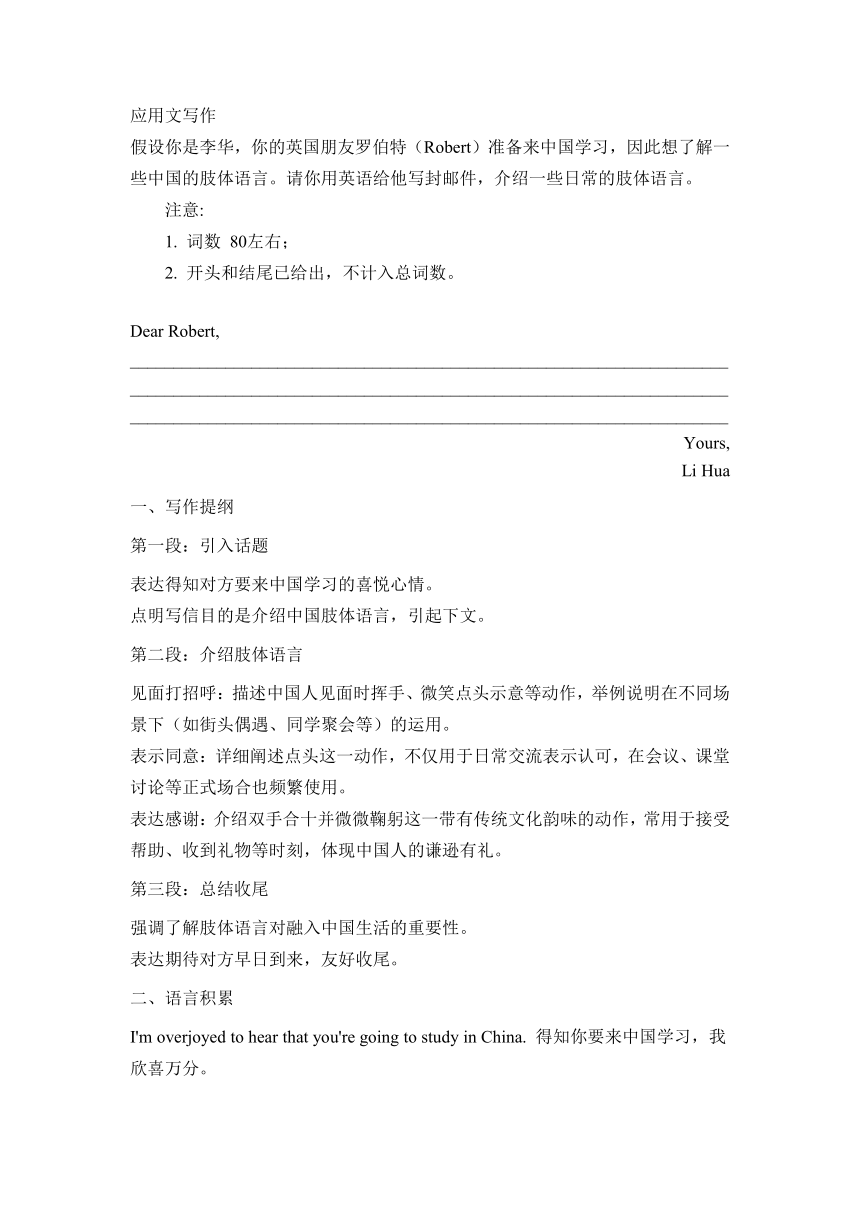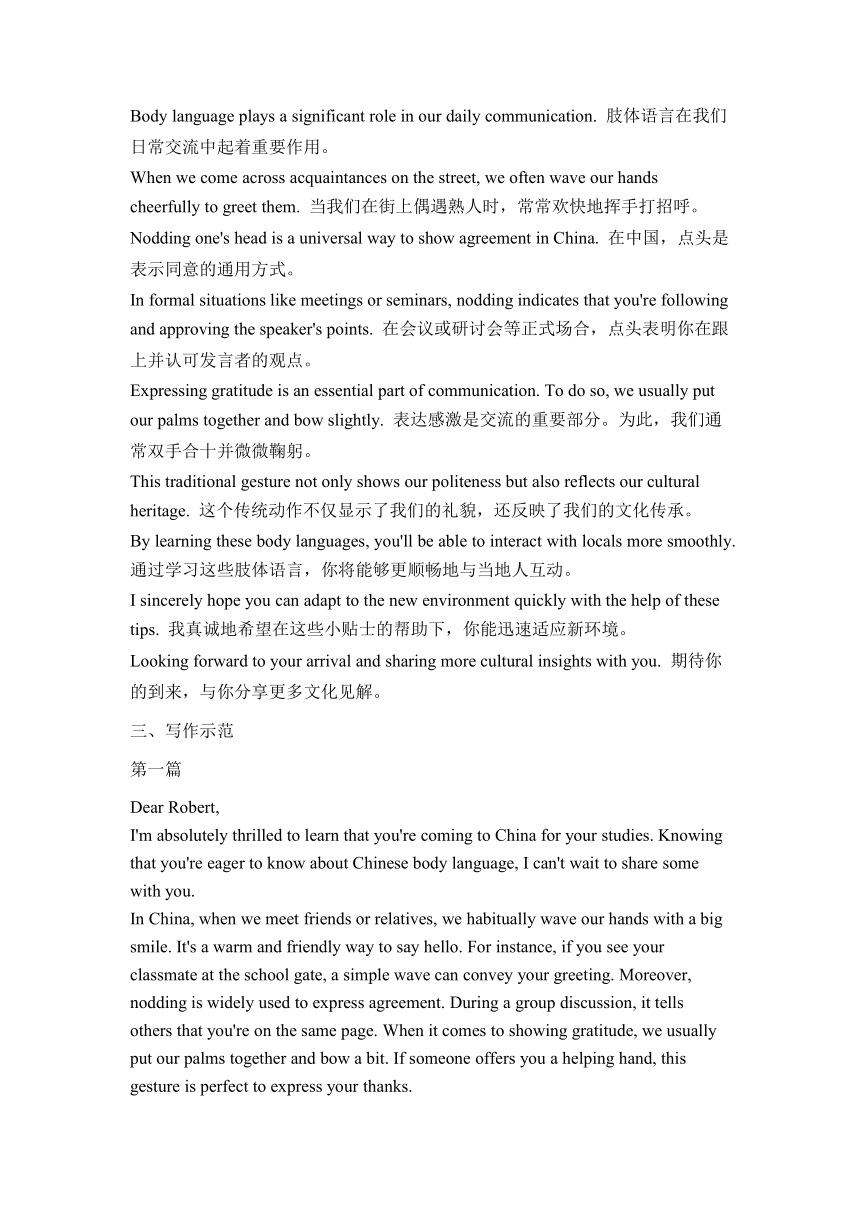应用文写作--给英国朋友罗伯特(Robert)用邮件分享一些中国的肢体语言 讲义-海南省2024-2025学年高二上学期第二次月考英语试题
文档属性
| 名称 | 应用文写作--给英国朋友罗伯特(Robert)用邮件分享一些中国的肢体语言 讲义-海南省2024-2025学年高二上学期第二次月考英语试题 |

|
|
| 格式 | docx | ||
| 文件大小 | 20.4KB | ||
| 资源类型 | 教案 | ||
| 版本资源 | 人教版(2019) | ||
| 科目 | 英语 | ||
| 更新时间 | 2025-01-06 10:45:59 | ||
图片预览


文档简介
应用文写作
假设你是李华,你的英国朋友罗伯特(Robert)准备来中国学习,因此想了解一些中国的肢体语言。请你用英语给他写封邮件,介绍一些日常的肢体语言。
注意:
1. 词数 80左右;
2. 开头和结尾已给出,不计入总词数。
Dear Robert,
_____________________________________________________________________
_____________________________________________________________________
_____________________________________________________________________
Yours,
Li Hua
一、写作提纲
第一段:引入话题
表达得知对方要来中国学习的喜悦心情。
点明写信目的是介绍中国肢体语言,引起下文。
第二段:介绍肢体语言
见面打招呼:描述中国人见面时挥手、微笑点头示意等动作,举例说明在不同场景下(如街头偶遇、同学聚会等)的运用。
表示同意:详细阐述点头这一动作,不仅用于日常交流表示认可,在会议、课堂讨论等正式场合也频繁使用。
表达感谢:介绍双手合十并微微鞠躬这一带有传统文化韵味的动作,常用于接受帮助、收到礼物等时刻,体现中国人的谦逊有礼。
第三段:总结收尾
强调了解肢体语言对融入中国生活的重要性。
表达期待对方早日到来,友好收尾。
二、语言积累
I'm overjoyed to hear that you're going to study in China. 得知你要来中国学习,我欣喜万分。
Body language plays a significant role in our daily communication. 肢体语言在我们日常交流中起着重要作用。
When we come across acquaintances on the street, we often wave our hands cheerfully to greet them. 当我们在街上偶遇熟人时,常常欢快地挥手打招呼。
Nodding one's head is a universal way to show agreement in China. 在中国,点头是表示同意的通用方式。
In formal situations like meetings or seminars, nodding indicates that you're following and approving the speaker's points. 在会议或研讨会等正式场合,点头表明你在跟上并认可发言者的观点。
Expressing gratitude is an essential part of communication. To do so, we usually put our palms together and bow slightly. 表达感激是交流的重要部分。为此,我们通常双手合十并微微鞠躬。
This traditional gesture not only shows our politeness but also reflects our cultural heritage. 这个传统动作不仅显示了我们的礼貌,还反映了我们的文化传承。
By learning these body languages, you'll be able to interact with locals more smoothly. 通过学习这些肢体语言,你将能够更顺畅地与当地人互动。
I sincerely hope you can adapt to the new environment quickly with the help of these tips. 我真诚地希望在这些小贴士的帮助下,你能迅速适应新环境。
Looking forward to your arrival and sharing more cultural insights with you. 期待你的到来,与你分享更多文化见解。
三、写作示范
第一篇
Dear Robert,
I'm absolutely thrilled to learn that you're coming to China for your studies. Knowing that you're eager to know about Chinese body language, I can't wait to share some with you.
In China, when we meet friends or relatives, we habitually wave our hands with a big smile. It's a warm and friendly way to say hello. For instance, if you see your classmate at the school gate, a simple wave can convey your greeting. Moreover, nodding is widely used to express agreement. During a group discussion, it tells others that you're on the same page. When it comes to showing gratitude, we usually put our palms together and bow a bit. If someone offers you a helping hand, this gesture is perfect to express your thanks.
Understanding these body languages will undoubtedly make your life in China much easier. I'm really looking forward to seeing you and helping you explore more about Chinese culture.
Yours,
Li Hua
第二篇
Dear Robert,
How exciting it is that you're about to embark on your study journey in China! Since you mentioned your interest in Chinese body language, here's a little guide for you.
When it comes to greeting, Chinese people love to use hand gestures. A light wave accompanied by eye contact is the most common way to acknowledge someone. You can use it when you enter a classroom and see your classmates. Another important one is the head nod. It doesn't just mean “yes” in a simple conversation but also shows your attentiveness in a lecture. And when you receive a kindness, like a gift from a neighbor, folding your hands and bowing slightly is a polite and respectful way to respond.
These body languages are the keys to unlocking a smoother cultural exchange. I hope you can master them soon. Can't wait for you to arrive!
Yours,
Li Hua
第三篇
Dear Robert,
I'm delighted to hear that you're planning to study in China. To help you blend in quickly, let me introduce you to some typical Chinese body language.
To start with, greeting in China can be quite vivid. We wave our hands high, especially when we spot a friend from afar. It's like shouting “Hi” without words. In a more formal setting, a gentle nod of the head is appropriate to show respect and understanding. For example, when your teacher explains something and you get it, a nod will let them know. Additionally, to express sincere gratitude, we bring our palms together and make a small bow. This action is deeply rooted in our traditions.
By familiarizing yourself with these, you'll find it easier to connect with people here. I'm eagerly awaiting your arrival and ready to introduce you to more interesting cultural elements.
Yours,
Li Hua
应用文范文:
Dear Robert,
I’m thrilled to hear that you’re coming to China for your studies! I’d love to introduce you to some common gestures here.
In China, nodding means agreement, while shaking your head indicates disagreement. We also use a handshake to show respect or greeting. Additionally, tapping your index finger on the table can show impatience or boredom. Lastly, placing your hand over your heart is a sign of respect or thanks.
I hope this brief introduction helps you adjust quickly to our culture. Looking forward to seeing you soon!
Yours,
Li Hua
假设你是李华,你的英国朋友罗伯特(Robert)准备来中国学习,因此想了解一些中国的肢体语言。请你用英语给他写封邮件,介绍一些日常的肢体语言。
注意:
1. 词数 80左右;
2. 开头和结尾已给出,不计入总词数。
Dear Robert,
_____________________________________________________________________
_____________________________________________________________________
_____________________________________________________________________
Yours,
Li Hua
一、写作提纲
第一段:引入话题
表达得知对方要来中国学习的喜悦心情。
点明写信目的是介绍中国肢体语言,引起下文。
第二段:介绍肢体语言
见面打招呼:描述中国人见面时挥手、微笑点头示意等动作,举例说明在不同场景下(如街头偶遇、同学聚会等)的运用。
表示同意:详细阐述点头这一动作,不仅用于日常交流表示认可,在会议、课堂讨论等正式场合也频繁使用。
表达感谢:介绍双手合十并微微鞠躬这一带有传统文化韵味的动作,常用于接受帮助、收到礼物等时刻,体现中国人的谦逊有礼。
第三段:总结收尾
强调了解肢体语言对融入中国生活的重要性。
表达期待对方早日到来,友好收尾。
二、语言积累
I'm overjoyed to hear that you're going to study in China. 得知你要来中国学习,我欣喜万分。
Body language plays a significant role in our daily communication. 肢体语言在我们日常交流中起着重要作用。
When we come across acquaintances on the street, we often wave our hands cheerfully to greet them. 当我们在街上偶遇熟人时,常常欢快地挥手打招呼。
Nodding one's head is a universal way to show agreement in China. 在中国,点头是表示同意的通用方式。
In formal situations like meetings or seminars, nodding indicates that you're following and approving the speaker's points. 在会议或研讨会等正式场合,点头表明你在跟上并认可发言者的观点。
Expressing gratitude is an essential part of communication. To do so, we usually put our palms together and bow slightly. 表达感激是交流的重要部分。为此,我们通常双手合十并微微鞠躬。
This traditional gesture not only shows our politeness but also reflects our cultural heritage. 这个传统动作不仅显示了我们的礼貌,还反映了我们的文化传承。
By learning these body languages, you'll be able to interact with locals more smoothly. 通过学习这些肢体语言,你将能够更顺畅地与当地人互动。
I sincerely hope you can adapt to the new environment quickly with the help of these tips. 我真诚地希望在这些小贴士的帮助下,你能迅速适应新环境。
Looking forward to your arrival and sharing more cultural insights with you. 期待你的到来,与你分享更多文化见解。
三、写作示范
第一篇
Dear Robert,
I'm absolutely thrilled to learn that you're coming to China for your studies. Knowing that you're eager to know about Chinese body language, I can't wait to share some with you.
In China, when we meet friends or relatives, we habitually wave our hands with a big smile. It's a warm and friendly way to say hello. For instance, if you see your classmate at the school gate, a simple wave can convey your greeting. Moreover, nodding is widely used to express agreement. During a group discussion, it tells others that you're on the same page. When it comes to showing gratitude, we usually put our palms together and bow a bit. If someone offers you a helping hand, this gesture is perfect to express your thanks.
Understanding these body languages will undoubtedly make your life in China much easier. I'm really looking forward to seeing you and helping you explore more about Chinese culture.
Yours,
Li Hua
第二篇
Dear Robert,
How exciting it is that you're about to embark on your study journey in China! Since you mentioned your interest in Chinese body language, here's a little guide for you.
When it comes to greeting, Chinese people love to use hand gestures. A light wave accompanied by eye contact is the most common way to acknowledge someone. You can use it when you enter a classroom and see your classmates. Another important one is the head nod. It doesn't just mean “yes” in a simple conversation but also shows your attentiveness in a lecture. And when you receive a kindness, like a gift from a neighbor, folding your hands and bowing slightly is a polite and respectful way to respond.
These body languages are the keys to unlocking a smoother cultural exchange. I hope you can master them soon. Can't wait for you to arrive!
Yours,
Li Hua
第三篇
Dear Robert,
I'm delighted to hear that you're planning to study in China. To help you blend in quickly, let me introduce you to some typical Chinese body language.
To start with, greeting in China can be quite vivid. We wave our hands high, especially when we spot a friend from afar. It's like shouting “Hi” without words. In a more formal setting, a gentle nod of the head is appropriate to show respect and understanding. For example, when your teacher explains something and you get it, a nod will let them know. Additionally, to express sincere gratitude, we bring our palms together and make a small bow. This action is deeply rooted in our traditions.
By familiarizing yourself with these, you'll find it easier to connect with people here. I'm eagerly awaiting your arrival and ready to introduce you to more interesting cultural elements.
Yours,
Li Hua
应用文范文:
Dear Robert,
I’m thrilled to hear that you’re coming to China for your studies! I’d love to introduce you to some common gestures here.
In China, nodding means agreement, while shaking your head indicates disagreement. We also use a handshake to show respect or greeting. Additionally, tapping your index finger on the table can show impatience or boredom. Lastly, placing your hand over your heart is a sign of respect or thanks.
I hope this brief introduction helps you adjust quickly to our culture. Looking forward to seeing you soon!
Yours,
Li Hua
同课章节目录
